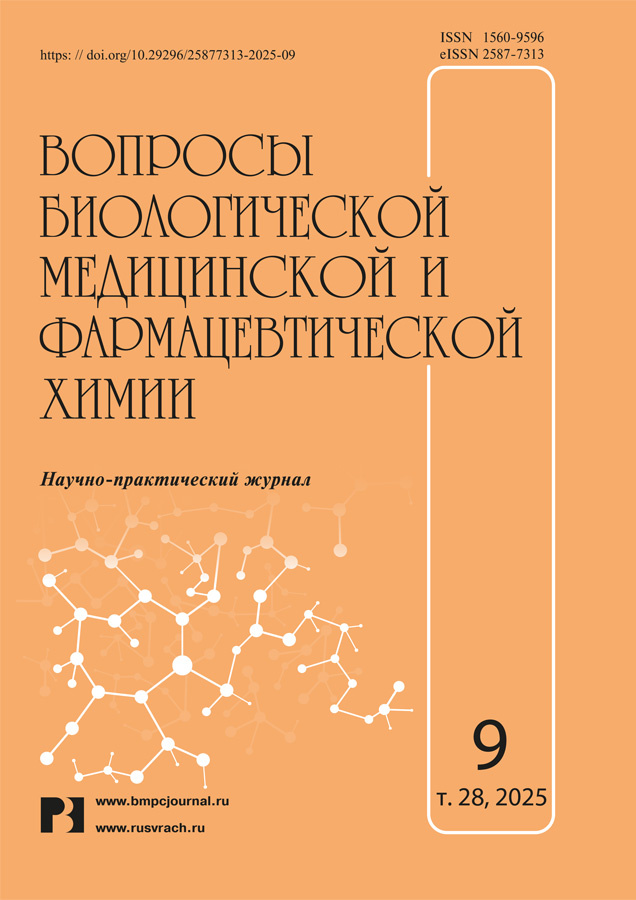Study of the correlation between CYP3A4 isoenzyme activity and the safety of erythromycin therapy in patients with bacterial complications of influenza
- Authors: Skryabina A.A.1, Nikiforov V.V.1, Sychev D.A.2
-
Affiliations:
- Pirogov Russian National Research Medical University of the Ministry of Health of the Russian Federation
- Russian Medical Academy of Postgraduate Education of the Ministry of Healthcare of the Russian Federation
- Issue: Vol 28, No 9 (2025)
- Pages: 52-57
- Section: Medical chemistry
- URL: https://journals.eco-vector.com/1560-9596/article/view/690138
- DOI: https://doi.org/10.29296/25877313-2025-09-07
- ID: 690138
Cite item
Abstract
Introduction. Macrolides are a class of broad-spectrum antibiotics that are prescribed for the treatment of various infectious diseases, both local and systemic. Although the use of macrolides is generally considered safe, some patients may be at risk of dose-dependent adverse drug reactions (ADRs), which may reduce the safety of treatment for this category of patients.
The aim of the study was to investigate the effect of CYP3A4 isoenzyme activity on the safety of erythromycin therapy in patients with bacterial complications of influenza.
Material and methods. An open-label, non-comparative, prospective study was conducted in which 40 patients with a confirmed diagnosis of bacterial complications of influenza affecting the lower respiratory tract (ICD-10 codes J10.0-J10.1) who were treated in an infectious diseases hospital, received erythromycin tablets for 5 days. CYP3A4 activity was assessed by high-performance liquid chromatography in relation to the concentrations of the endogenous substrate and its metabolite in urine (6β-hydroxycortisol/cortisol).
Results. and discussion: It was found that the metabolic ratio values on day 1 of the study (corresponding to the baseline level of CYP3A4 isoenzyme activity) and in the dynamics were significantly lower in patients with any recorded NLE. It was also found that the occurrence of nausea was significantly more frequent in patients with low baseline CYP3A4 activity. No statistically significant associations with the metabolic ratio were found for the other individual ADRs.
Conclusions. The study in patients with bacterial complications of influenza demonstrated the influence of CYP3A4 isoenzyme activity on the safety of erythromycin therapy. Thus, determining the level of CYP3A4 activity may allow predicting the development of nausea during erythromycin use.
Full Text
About the authors
A. A. Skryabina
Pirogov Russian National Research Medical University of the Ministry of Health of the Russian Federation
Author for correspondence.
Email: anna.skryabina.85@mail.ru
ORCID iD: 0000-0002-2098-222X
SPIN-code: 3692-6818
Assistant, Department of Infectious Diseases and Epidemiology, Faculty of Medicine
Russian Federation, st. Ostrovityanova, 1, Moscow, 117513V. V. Nikiforov
Pirogov Russian National Research Medical University of the Ministry of Health of the Russian Federation
Email: sardonios@mail.ru
ORCID iD: 0000-0002-8145-0235
SPIN-code: 9044-5289
Dr.Sc. (Med.), Professor, Head of the Department of Infectious Diseases and Epidemiology, Faculty of Medicine
Russian Federation, st. Ostrovityanova, 1, Moscow, 117513D. A. Sychev
Russian Medical Academy of Postgraduate Education of the Ministry of Healthcare of the Russian Federation
Email: d.a.sychev.rmapo@rambler.ru
ORCID iD: 0000-0002-4496-3680
SPIN-code: 4525-7556
Dr.Sc. (Med.), Professor, Academician of the Russian Academy of Sciences, Head of the Department of Clinical Pharmacology and Therapy
Russian Federation, 2/1, building 1, Barrikadnaya st., Moscow, 125993References
- Lazareva N.B., Rebrova E.V., Ryazanova A.Yu. i dr. Makrolidy: sovremennaya poziciya v pulmonologicheskoj praktike. Prakticheskaya pulmonologiya. 2019; 1: 66–77. (In Russ.).
- Hansen M.P., Scott A.M., McCullough A. et al. Adverse events in people taking macrolide antibiotics versus placebo for any indication. Cochrane Database Syst Rev. 2019 Jan 18; 1(1): CD011825. doi: 10.1002/14651858.CD011825.pub2.
- Lynch T., Price A. The effect of cytochrome P450 metabolism on drug response, interactions, and adverse effects. Am Fam Physician. 2007 Aug 1; 76(3): 391–396.
- Naranjo C.A., Busto U., Sellers E.M. et al. A method for estimating the probability of adverse drug reactions. Clin Pharmacol Ther. 1981 Aug; 30(2): 239–245. doi: 10.1038/clpt.1981.154.
- Smirnov V.V., Savchenko A.Yu., Ramenskaya G.V. Razrabotka i validaciya metodiki kolichestvennogo opredeleniya endogennogo kortizola i 6-b-gidroksikortizola v moche s celyu opredeleniya aktivnosti izofermenta CYP3A4. Biomedicina. 2010; 4: 56–60. (In Russ.).
- Egorenkov E.A., Smirnov V.V., Kuzina V.N. i dr. Metodiki fenotipirovaniya izofermenta CYP3A4, primenyaemye dlya personalizacii farmakoterapii. Vedomosti Nauchnogo centra ekspertizy sredstv medicinskogo primeneniya. Regulyatornye issledovaniya i ekspertiza lekarstvennyh sredstv. 2017; 7(1): 20–24. (In Russ.).
- Skryabin V.Y., Zastrozhin M.S., Grishina E.A. et al. Using the CYP3A Activity Evaluation to Predict the Efficacy and Safety of Diazepam in Patients with Alcohol Withdrawal Syndrome. J Pharm Pract. 2022 Aug; 35(4): 518–523. doi: 10.1177/0897190021997000.
- Zastrozhin M.S., Skryabin V.Y., Sorokin A.S. et al. CYP3A subfamily activity affects the equilibrium concentration of Phenazepam in patients with anxiety disorders and comorbid alcohol use disorder. Pharmacogenomics. 2020 May; 21(7): 449–457. doi: 10.2217/pgs-2019-0071.
Supplementary files






